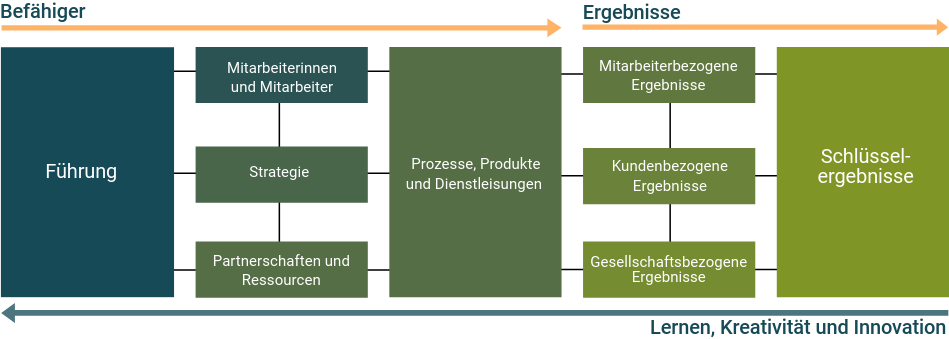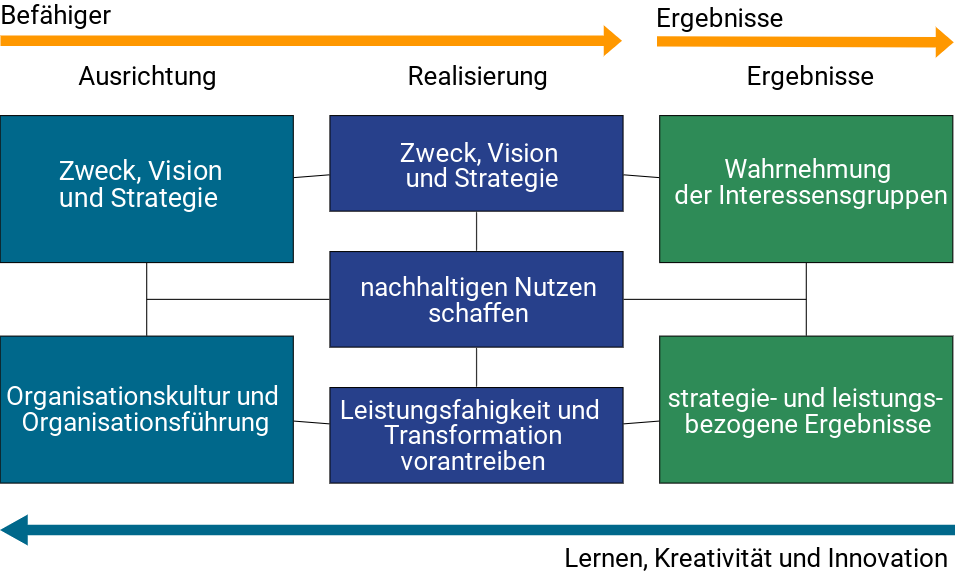European Foundation for Quality Management
A model for finding best practices in human resource management
Basics of the EFQM model
Meaning
The model of the European Foundation for Quality Management, EFQM model for short, is based on European values, which were already defined in 1953 in the European Convention on Civil Rights
and in the 1996 revised European Social Charter
have been recorded. In particular, the UN Global Compact with its ten principles has influenced the EFQM model - excellent organizations respect and adhere to these rules, regardless of legal obligations.
Components for corporate success
In order to recognize sustainable corporate success, to provide food for thought, means and ways, the EFQM model draws on three components:
1. What? - eight principles as the basic concept of excellence (value framework)
As part of a holistic approach to excellence:
- create value for customers and,
- to shape the future sustainably.
To achieve this will:
- develops the capabilities of the (own) organization,
- Creativity and innovation encouraged,
- led with vision, inspiration and integrity.
As a result:
- Changes not only endured, but actively managed,
- the company's success is understood as the success of its employees,
- which aims for permanently outstanding results.
2. How/Through & For What? - nine criteria for implementing excellence
The question of the How to excellence
answers the criteria model with its nine main and 32 sub-requirements, which are divided into the two basic areas, Enabler(s)
(who/what) and Results
(for what). These interact with each other - enablers enable results, results are the starting point for possible improvements of the enabler. The more dynamic the enablers, the more dynamic the results.
Enablers are measured against five criteria:
- Managers with vision, creative drive and creative competence,
- own strategy is aligned with stakeholders through guidelines, plans and processes,
- Appreciating and motivating employees, developing their skills and promoting fairness and equality,
- manage partnerships, supply processes and resources, ensuring that the impact on the environment and society is effectively managed,
- actively design, steer and improve their own portfolio of processes, products and services with a view to creating value for customers and other stakeholders. Very good and outstanding, lasting results are recorded in four areas:
- operational and strategic results,
- Needs and expectations of their customers,
- Needs and expectations of employees,
- Needs and expectations of society and its shareholders and stakeholders,
- operational and strategic results that meet the needs and expectations of its customers, its employees, society, and its shareholders and stakeholders.
3. With what - Synthesis of principles and criteria + RADAR logic for checking excellence
The RADAR logic as an evaluation tool is used to check the criteria in which the eight principles of the value framework are successfully implemented. The RADAR acronym (Results, Approach, Deployment, Assesment & Refinement) is based on results that are to be achieved, derives procedures from these results (approach) and systematically deploys them. Finally, the results achieved are analyzed in order to generate learning effects and implement improvement measures.
The EFQM model provides a large number of orientation points for this purpose. For the first enabler criterion "Leadership", there are already 31, divided into the five respective sub-aspects specified by the EFQM Model.
EFQM Model Adaptation 2019
in 2019, the EFQM model was revised and published in an adapted version. In doing so, the consideration of current topics, other terms as well as a different view on trends should enable a more modern reflection on excellent organizations. The 2019 model can also be divided into three major areas:
1. What? - Two criteria as a conception of excellence
The fundamental characteristic of excellent organizations is an inspiring purpose or vision, implemented through an effective strategy. As part of the revision of the EFQM model, this first set of criteria replaces or corresponds to the eight basic concept principles of the 2013 EFQM model. It sets out why the organization's activities are important for creating and delivering sustainable value to its stakeholders (purpose). Long-term goals set are described, decisions and courses of action are transparent and clear as a result (vision). These serve as the basis for concrete plans and priorities of the organization (strategy). With a suitable own imprint (organizational culture), own values are guided and the framework conditions for these are determined, i.e. changes are actively lived, creativity and innovations (innovation) are enabled and promoted, and togetherness is strengthened.
2. How/With what? - three criteria for implementing excellence
The EFQM model assumes that the action imperatives of excellent organizations are quite similar. There are specific stakeholders with individual priorities whose sustainable benefit is of crucial importance for excellent organizations and can (only) be achieved by preserving and increasing one's own performance and adaptability. The right approach then includes, among other things, concrete specifications such as analyzing the stakeholder groups, integrating them into one's own strategy, and proactively addressing them. In this way, the benefits for these stakeholders can be planned, developed, communicated, marketed and created as an overall result. To do this, one's own organization is adapted to current and future requirements. Innovations are promoted and technology as well as data and other resources are actively used and managed.
3. For what? - two criteria for checking excellence
In the 2019 EFQM model, results are also grouped according to how they are perceived by the stakeholders involved, as well as strategy and performance-related results. In the 2013 model, a distinction was made between employees, customers, society and key results. These have been combined or reorganized into the category of relevant stakeholder results and the category of strategy and performance-related results. On the one hand, this therefore includes key results such as the perception of customers, the company's own employees, suppliers and society. On the other hand, it also includes indicators related to sustainable benefits, indicators related to financial results or financial ratios.
Fair-Karriere.de and EFQM
Context
The Faire-Karriere.de maturity model is an adapted variant of the EFQM model that focuses on seven criteria. It focuses on excellent HR work with the aim of balancing the needs of the HR-relevant stakeholder groups organization, management, employees, employee representatives, customers, partners and the environment.
Faire-Karriere offers participating organizations the opportunity for self-assessment and external assessment. Stakeholders involved (managers, employees, employee representatives, partners and customers) can assess an organization according to the seven criteria of Faire-Karriere.de and thus express their view of the maturity level.
Fair-Career.com Self-Assessment
With the help of the self-assessment, each organization can determine its level of maturity and progress toward an excellent human resources organization and compare it with the external assessment. This allows improvement measures to be derived in a very targeted manner. The simple self-assessment is carried out directly in the Faire-Karriere.de profile, based on the RADAR assessment according to EFQM. Once the self-assessment has been completed, each organization is free to share its assessment with the other Faire-Karriere organizations. For this purpose, each organization is shown other Faire Career organizations for each criterion that have higher third-party and self-assessment results. Provided you have unlocked your own results to share (give and take).
Fair-Career.com Maturity Level
The maturity level of HR management is determined for each of the seven principles of Faire-Karriere.de by answering the following questions. This is based on the RADAR assessment of the EFQM organization. The first question checks whether there are any concrete procedures at all for complying with the respective Fair-Career rule. Only then can the following questions on the quality of the approach (questions 2.1 and 2.2), on implementation (3.1 and 3.2) and on regular measurement and improvement (4.1 and 4.2) be answered. Depending on how strongly one rates oneself on the individual questions, this results in an overall score or maturity level per fair career rule.
- Does your company have a specific procedure for this?
- Is this approach justified and based on the needs of all relevant stakeholders?
- Does this approach support the strategy and dovetail with other relevant approaches?
- Is this procedure backed up by processes and clear responsibilities, and is it scheduled in terms of time and deadlines?
- Has this procedure been introduced in all relevant areas of the company?
- Are the efficiency and effectiveness (key figures, feedback) of the procedure and its implementation regularly measured, evaluated and discussed in an appropriate manner?
- Has the approach been improved or developed through analysis or innovation in the last 3 years?
Conclusion
In the course of the revision of the underlying EFQM model in 2019 (see EFQM Model 2013 and EFQM Model 2019), the question arose as to whether the Fair Career Model would also have to be revised and adapted to the new EFQM model. However, the differences in content between the two EFQM models are (in our opinion) too minor for a complete revision of the Fair Career Model to be necessary. The individual thematic blocks and criteria of the EFQM model can be merged quite easily. The graphical scheme from 2019 is also quite easy to map into the design of the model from 2013. We are therefore of the opinion that the tried-and-tested Fair Career Model continues to make sense.

